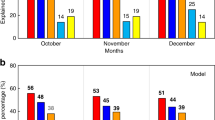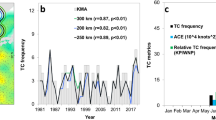Abstract
During the second half of 2014, the tropical Pacific was in a state marginally consistent with El Niño. While oceanic indicators were indicative of a weak El Niño event, a number of atmospheric indicators were not, and a number of forecast centers did not declare an El Niño. Nonetheless, the most active tropical cyclone basins of the northern hemisphere—those of the North Atlantic and Pacific—showed tropical cyclone statistics that in some respects were consistent with El Niño. In particular, the numbers of relatively intense storms in the four basins considered—major hurricanes in the Eastern North Pacific and North Atlantic, super typhoons in the Western North Pacific, and hurricanes in the Central North Pacific—formed a pattern strongly consistent with El Niño.





Similar content being viewed by others
Notes
The US Weather Service Web site for ENSO is http://www.cpc.ncep.noaa.gov/products/analysis_monitoring/enso_advisory/index.shtml, the Australian Bureau of Meteorology Web site for ENSO is http://www.bom.gov.au/climate/enso; the World Meteorological Organization ENSO website is http://www.wmo.int/pages/themes/climate/el_nino_la_nina.php.
The Japanese Meteorological Agency website for ENSO is http://ds.data.jma.go.jp/tcc/tcc/products/elnino/.
References
Ashok K, Behera SK, Rao SA, Weng H, Yamagata T (2007) El Niño modoki and its possible teleconnection. J Geophys Res 112:C11007. doi:10.1029/2006JC003798
Balaguru K, Ruby L, Yoon JH (2013) Oceanic control of Northeast Pacific hurricane activity at interannual timescales. Environ Res Lett 8:044009. doi:10.1088/1748-9326/8/4/044009
Barnston AG, Li S, Mason SJ, deWitt DG, Goddard L, Gong X (2010) Verification of the first 11 years of IRI’s seasonal climate forecasts. J Appl Meteorol Climatol 49:493–520. doi:10.1175/2009JAMC2325.1
Barnston AG, Tippett MK, L’Heureux ML, Li S, DeWitt DG (2012) Skill of real-time seasonal ENSO model predictions during 2002–2011. Is our capability increasing? Bull Am Meteorol Soc 93:631–651. doi:10.1175/BAMS-D-11-00111.1
Bell GD, Halpert MS, Schnell RC, Higgins RW, Lawrimore J, Kousky VE, Tinker R, Thiaw W, Chelliah M, Artusa A (2000) Climate assessment for 1999. Bull Am Meteorol Soc 81:S1–S50
Bell GD, Blake ES, Landsea CW, Goldenberg SB, Kimberlain TB, Pasch RJ, Schemm J (2015) Atlantic basin. In: State of the climate in 2014. Bull Am Meteorol Soc 96(7):S101–S107
Blake ES, Gibney EJ, Brown DP, Mainelli M, Franklin JL, Kimberlain TB, Hammer GR (2009). Tropical cyclones of the eastern North Pacific basin, 1949–2006. In: Historical climatology series 6-5. National Climate Data Center, Ashville, NC
Bove MC, Elsner JB, Landsea CW, Niu X, O’Brien J (1998) Effect of El Niño on US landfalling hurricanes, revisited. Bull Am Meteorol Soc 79:2477–2482
Camargo SJ (2015) Western North Pacific basin. In: State of the climate in 2014. Bull Am Meteorol Soc 96 (7):S112–S115
Camargo SJ, Barnston AG (2009) Experimental seasonal dynamical forecasts of tropical cyclone activity at IRI. Weather Forecast 24:472–491
Camargo SJ, Sobel AH (2005) Western North Pacific tropical cyclone intensity and ENSO. J Clim 18:2996–3006
Camargo SJ, Robertson AW, Gaffney SJ, Smyth P, Ghil M (2007) Cluster analysis of typhoon tracks. Part II: large-scale circulation and ENSO. J Clim 20:3654–3676
Camargo SJ, Robertson AW, Barnston AG, Ghil M (2008) Clustering of eastern North Pacific tropical cyclone tracks: ENSO and MJO effects. Geochem Geophys and Geosys 9:Q06V05. doi:10.1029/2007GC001861
Camargo SJ, Sobel AH, Barnston AG, Klotzbach PJ (2010) The influence of natural climate variability on tropical cyclones and seasonal forecasts of tropical cyclone activity. In: Chan JCL, Kepert JD (eds) Global perspectives on tropical cyclones, from science to mitigation, 2nd edn., Series on earth system science in Asia chap 11, pp. 325–360. World Scientific, Singapore
Chan JCL (1985) Tropical cyclone activity in the Northwest Pacific in relation to El Niño/southern oscillation phenomenon. Mon Weather Rev 113:599–606
Chia HH, Ropelewski CF (2002) The interannual variability in the genesis location of tropical cyclones in the Northwest Pacific. J Clim 15:2934–2944
Chu PS (2004) Hurricanes and typhoons, past, present and future. In: Murnane RJ, Liu K-B (eds) ENSO and tropical cyclone activity. Columbia University Press, New York, pp 297–332
Chu JH, Sampson CR, Levine AS, Fukada E (2002) The joint typhoon warning center tropical cyclone best-tracks, 1945–2000. Tech Rep. NRL/MR/7540-02-16, Naval Research Laboratory
Davis K, Zeng X, Ritchie EA (2015) A new statistical model to predict seasonal North Atlantic hurricane activity. Weather Forecast 30:730–741. doi:10.1175/WAF-D-14-00156.1
Dee DP, Uppala SM, Simmons AJ, Berrisford P, Poli P, Kobayashi S, Andrea U, Balmaseda MA, Balsamo G, Bauer P, Bechtold P, Beljaars ACM, van de Berg L, Bidlot J, Bormann N, Delsol C, Dragani R, Fuentes M, Geer A, Haimberger L, Healy S, Hersbach H, Hólm EV, Isaksen L, Kållberg P, Köhler M, Matricardi M, McNally AP, Monge-Sanz BM, Morcrette JJ, Park BP, Peubey C, de Rosnay P, Tavolato C, Thépaut JN, Vitart F (2011) The ERA-interim reanalysis: configuration and performance of the data assimilation system. Quart J R Meteorol Soc 137:553–597
Fogarty CT, Klotzbach P (2015) 2013 versus 2014 Atlantic hurricane activity - Brief comparison of two below-average seasons. In: State of the climate in 2014. Bull Am Meteorol Soc 96 (7):S104–S105
Frank WM, Young GS (2007) The interannual variability of tropical cyclones. Mon Weather Rev 135:3587–3598
Goddard L, Dilley M (2005) El Niño: catastrophe or opportunity? J Clim 18:651–665
Goddard L, Kumar A, Hoerling MP, Barnston AG (2006) Diagnosis of anomalous winter temperatures over the eastern United States during the 2002/03 El Niño. J Clim 19:5624–5636
Gray WM (1984) Atlantic seasonal hurricane frequency. Part I: El-Niño and 30-MB quasi-biennial oscillation influences. Mon Weather Rev 112:1649–1688
Irwin RP, Davis RE (1999) The relationship between the Southern oscillation index and tropical cyclone tracks in the eastern North Pacific. Geophys Res Lett 26:2251–2254
Jin EK, Kinter J, Wang B, Park CK, Kang IS, Kirtman BP, Kug JS, Kumar A, Luo JJ, Schemm J, Shukla J, Yagamata T (2008) Current status of ENSO prediction skill in coupled ocean-atmosphere models. Clim Dyn 31:647–664
Jin FF, Boucharel J, Lin II (2014) Eastern Pacific tropical cyclones intensified by El Niño delivery of subsurface ocean heat. Nature 516:82–85
Johnson NC (2013) How many ENSO flavors can we distinguish? J Clim 26:4816–4827
Kim H, Webster PJ, Curry JA (2009) Impact of shifting patterns of Pacific Ocean warming on North Atlantic tropical cyclones. Science 325:77–80
Kimberlain TB, Blake ES, Cangialosi JP (2016) Hurricane patricia. Tropical Cyclone Report, National Hurricane Center, Miami, FL. http://www.nhc.noaa.gov/data/tcr/EP202015_Patricia
Klotzbach PJ, Gray WM (2009) Twenty-five years of Atlantic basin seasonal hurricane forecasts (1984–2008). Geophys Res Lett 36:L09711
Kruk MC, Schreck CJ, Evans T (2015) Eastern North Pacific and Central North Pacific basins. In: State of the climate in 2014. Bull Am Meteorol Soc 96 (7):S107–S112
Landsea CW (2000) El Niño: impacts of multiscale variability on natural ecosystems and society. In: Díaz HF, Markgraf V (eds) El Niño-southern oscillation and the seasonal predictability of tropical cyclones. Cambridge University Press, Cambridge, pp 149–181
Landsea CW, Franklin JL (2013) Atlantic hurricane database uncertainty and presentation of a new database format. Mon Weather Rev 141:3576–3592
Landsea CW, Knaff JA (2000) How much skill was there in forecasting the very strong 1997–1998 El Niño? Bull Am Meteorol Soc 81:2107–2119
Levitus S, Antonov JI, Boyer TP, Barnova OK, Garcia HE, Locarnini A, Mishonov AV, Reagan JR, Seidov D, Yarosh ES, Zweng MM (2012) World ocean heat content and thermosteric sea level change (0–2000 m), 1955–201. Geophys Res Lett 39:L10603. doi:10.1029/2012GL051106
L’Heureux M, Halpert M, Bell GD (2015) ENSO and the tropical Pacific. In: State of the climate in 2014. Bull Am Meteorol Soc 96 (7):S91–S93
Liebmann B, Smith CA (1996) Description of a complete (interpolated) outgoing longwave radiation dataset. Bull Am Meteorol Soc 77:1275–1277
Lin II, Black P, Price F, Yang CY, Chen SS, Lien CC, Harr P, Chi NH, Wu CC, D’Asaro EA (2013) An ocean coupling potential intensity index for tropical cyclone. Geophys Res Lett 40:1878–1882. doi:10.1002/grl.50091
Livezey RE, Timofeyeva MM (2008) The first decade of long-lead U.S. seasonal forecasts. Bull Am Meteorol Soc 89:843–854. doi:10.1175/2008BAMS2488.1
Maue RN (2009) Northern hemisphere tropical cyclone activity. Geophys Res Lett 36:L05805
Maue RN (2011) Recent historically low global tropical cyclone activity. Geophys Res Lett 38:L14803
McPhaden MJ (2015) Playing hide and seek with el Niño. Nat Clim Change 5:791–795. doi:10.1038/nclimate2775
McPhaden MJ, Timmermman A, Widlansky MJ, Balsameda MA, Stockdale TN (2015) The curious case of the El Niño that never happened: a perspective from 40 years of progess in climate research and forecasting. Bull Am Meteorol Soc 96:1647–1665. doi:10.1175/BAMS-D-14-00089.1
Murakami H, Vecchi GA, Delworth T, Paffendorf K, Gudgel R, Jia L, Zheng F (2015) Investigating the influence of anthropogenic forcing and natural variability on the 2014 Hawaiian hurricane season. In: Explaining extremes of 2014 from a climate perspective. Bull Am Meteorol Soc 96(12):S115–S119
Reynolds RW, Rayner NA, Smith TM, Stokes DC, Wang W (2002) An improved in situ and satellite SST analysis for climate. J Clim 15:1609–1625
Smith TM, Reynolds RW (2004) Improved extended reconstruction of SST (1854–1997). J Clim 17:2466–2477
Tippett MK, Sobel AH, Camargo SJ (2012) Association of monthly U.S. tornado occurrence with large-scale atmospheric parameters. Geophys Res Lett 39:L02801. doi:10.1175/2011GL050368
Vecchi GA, Delworth R, Gudgel R, Kapnick S, Rosati A, Wittenberg AT, Zeng F, Anderson W, Balaji V, Dixon K, Jia L, Kim HS, Krishnamurty L, Msadek R, Stern WF, Underwood SD, Villarini G, Yang X, Zhang S (2014) On the seasonal forecasting of regional tropical cyclone activity. J Clim 27:7994–8016
Vincent EM, Emanuel KA, Lengaigne M, Vialard J, Madec G (2014) Influence of upper-ocean stratification interannual variability on tropical cyclones. J Adv Model Earth Syst 6:680–699. doi:10.1002/2014MS00032
Vitart F, Huddleston MR, Déqué M, Peake D, Palmer TN, Stockdale TN, Davey MK, Inenson S, Weisheimer A (2007) Dynamically-based seasonal forecasts of Atlantic tropical storm activity issued in June by EUROSIP. Geophys Res Lett 34:L16815. doi:10.1029/2007GL030740
Yang L, Wang X, Huang K, Wang D (2015) Anomalous tropical cyclone activity in the western North Pacific in August 2014. In: Explaining extremes of 2014 from a climate perspective. Bull Am Meteorol Soc 96(12):S120–S125
Zhang W, Leung Y, Fraedrich K (2015) Different El Niño types and intense typhoons in the Western North Pacific. Clim Dyn 44:2965–2977. doi:10.1007/s00382-014-2446-4
Author information
Authors and Affiliations
Corresponding author
Additional information
This research was supported by NOAA grant NA11OAR4300193 and by an AXA Award from the AXA Research Fund.
Appendix: Logistic regression model
Appendix: Logistic regression model
Using the standard logistic regression model, the probability that a given year is an El Niño is formulated as
where \(x_1, x_2, x_3, x_4\) are the number of super typhoons in the Western North Pacific, the number of hurricanes in the Central Pacific, the number of major hurricanes in the Eastern Pacific, and the number of major hurricanes in the Northern Atlantic , while \(x_5\) is an interaction term computed as \((x_1 x_2 x_3)/(x_4+1)\), with the addition of 1 in the denominator to prevent division by zero in years with no major Atlantic hurricanes. The coefficients are determined in matlab by the function “glmfit” and are
if the year 1992 is included. If 1992 is excluded, we get
The signs of most of the coefficients are consistent with our expectations based on our understanding of the influence of ENSO on TCs. The exception is \(b_3\), the eastern Pacific coefficient, which is highly uncertain (essentially indistinguishable from zero); this can be understood from Fig. 3c, which shows that several neutral and La Niña years had large numbers of major hurricanes in the Eastern North Pacific. The wide confidence intervals on the estimates of the probability that 2014 was an El Niño year (see Sect. 3.4) reflect the uncertainties on the coefficients in the model. As this might be due to collinearity between the predictors, we examined alternate models using fewer predictors (but retaining the Western and Central North Pacific). These did not lead to differences large enough to change our interpretation, for either the central probability estimate (which remains above 90 % in all cases tested) or the width of the confidence interval.
Rights and permissions
About this article
Cite this article
Sobel, A.H., Camargo, S.J., Barnston, A.G. et al. Northern hemisphere tropical cyclones during the quasi-El Niño of late 2014. Nat Hazards 83, 1717–1729 (2016). https://doi.org/10.1007/s11069-016-2389-7
Received:
Accepted:
Published:
Issue Date:
DOI: https://doi.org/10.1007/s11069-016-2389-7




